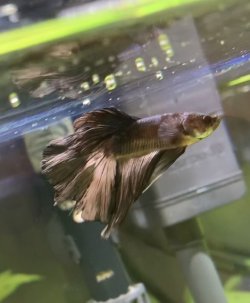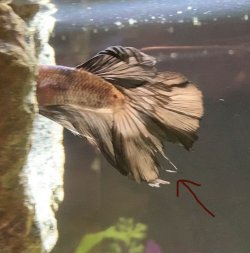alli789
New Member
My betta has fin rot. I've been treating for just under a week so I'm sure I just need to be patient, but I've only had the little guy about 2 months, so I'm really hoping he can recover. I started treating with catappa leaves 6 days ago. I had one leaf in the tank and the water was slightly noticeably dark. I just added a second leaf to the tank yesterday to get more tannins and today the water is nice and dark. How quickly should I see improvement? I think his fins look a bit worse today, as there's a new stringy piece that almost looks like it's about to fall off. Photos below, the one where he's facing right is last week and the ones where he's facing left were today.
Please let me know opinions. Does he look way worse than last week? I'm new to this and I just want to help my little guy.
If the leaves don't seem to work, I think I'll try aquarium salt next? I hear mixed things about medications so I'm trying to use natural remedies first but if anyone more experienced has other recommendations please let me know.
Also, he wraps his tail around things a lot. He's always done it. It's almost always his heater, but I'll occasionally see him do it to other stuff, like his logs, as well. I wanted to make sure this isn't a sign of something bad? I read that he probably just likes the warmth or he's cold but I didn't know if it could be affecting the fin rot.
(My tank is fully cycled, 10 gallons heated at 78 degrees. Tested parameters last week when I noticed the fin rot and ammonia and nitrite were both zero, should still be. Nitrate was 25, and due to high tap nitrates that's the lowest I've ever recorded them. So, parameters seem very good for my tank. I'm doing 20% water changes weekly and I'm thinking I'll add in an additional 10% change mid week until the fin rot clears up? I'm kind of unable to do more often or larger water changes as my tap water is very high in nitrate, so I use a blend with distilled water to bring it down. I also have hard water, so I have to bypass the softener and the water is cold. It's complicated and hard to explain in full, but if I do bigger changes, the tank temperature will drop too low.)
Please let me know opinions. Does he look way worse than last week? I'm new to this and I just want to help my little guy.
If the leaves don't seem to work, I think I'll try aquarium salt next? I hear mixed things about medications so I'm trying to use natural remedies first but if anyone more experienced has other recommendations please let me know.
Also, he wraps his tail around things a lot. He's always done it. It's almost always his heater, but I'll occasionally see him do it to other stuff, like his logs, as well. I wanted to make sure this isn't a sign of something bad? I read that he probably just likes the warmth or he's cold but I didn't know if it could be affecting the fin rot.
(My tank is fully cycled, 10 gallons heated at 78 degrees. Tested parameters last week when I noticed the fin rot and ammonia and nitrite were both zero, should still be. Nitrate was 25, and due to high tap nitrates that's the lowest I've ever recorded them. So, parameters seem very good for my tank. I'm doing 20% water changes weekly and I'm thinking I'll add in an additional 10% change mid week until the fin rot clears up? I'm kind of unable to do more often or larger water changes as my tap water is very high in nitrate, so I use a blend with distilled water to bring it down. I also have hard water, so I have to bypass the softener and the water is cold. It's complicated and hard to explain in full, but if I do bigger changes, the tank temperature will drop too low.)
Attachments
Last edited:




